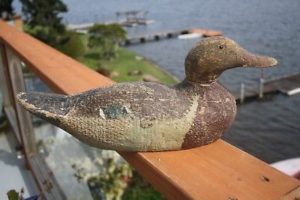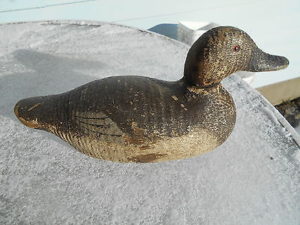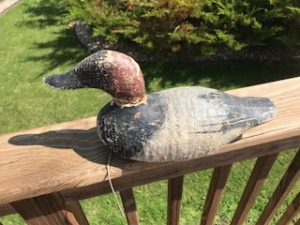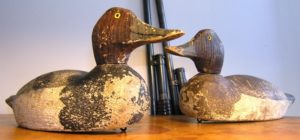Missouri was home to only a few factory decoy manufacturers. The Hays Decoy Co. was sold to the Gundelfinger family in 1925 when their business failed. Gundelfinger purchased all of the decoy
making equipment (lathes, sanders, patterns, etc.) and inventory and began producing wood decoys in Jefferson City, Missouri in late 1925.
Gundelfinger retained the same two model names introduced by Hays, the Grand Prix and Superior. The Superior model had little surface sanding and retained the “feather” finish surface and was solid wood. The Grand
Prix model was a hollow 2-piece wood decoy. Gundelfinger carried on the Hays skill and craftsmanship of individual scratch and comb painting on all their decoys.
Old decoy catalogs listed Gundelfinger decoys as trade name “Ducklure”. A water transfer decal or paper label was applied to the bottom of most of their decoys. As you would expect, very few stamps or decals survived after contact with water. Gundelfinger produced most species including canvasback, pintail, redhead, teal mallard, bluebills, goose and coot. Other species produced are more rare. According to the catalog, all their decoys were made from Idaho cedar. 1925 prices were $12 a dozen for Superior models and $21 a dozen for Grand Prix models.
It takes a special talent and attention to identify Gundelfinger decoys from some similar like Masons. Several specific identifying traits are noted for Gundelfingers:
- scratch painting on decoy backs was standard,
- there was usually a painted bill separation on most models,
- perpendicular comb painting on Drake backs and side pockets,
- poor paint adherence to primer (most have lots of flaking paint),
- many had a carved “u” notch on the front and rear of the bill, and
- some had a visible bottom stamp or decal
In 1928, Gundelfinger began to feel the financial pinch and soon after declared bankruptcy in March of 1929. A Jefferson City businessman, Harry Benz, purchased the Gundelfinger assets which was the beginning of the third decoy company in Missouri, Benz Decoy Co.
Gundelfinger decoys have yet to go through a serious appreciation of value, however their paint schemes are very good and can compete with the Masons.
I was recently surprised that a Gundelfinger decoy came up on an on-line auction in Green Bay, WI. Although not advertised as a “Gundelfinger”, I was able to acquire a good condition canvasback for $12.50 at auction. So… some good examples are still available at reasonable costs. Internet decoy collectors offer Gundelfinger decoys in the range of $200-$300 for pristine examples and more for rare species.
Craftsmanship and painting on Gundelfinger decoys is exceptional and are find examples of factory wood decoys produced in the 1920’s. Certainly a fine addition to any mantel, a classic decoy that is almost 100 years old!
As always, consult with a reputable decoy collector or appraiser before purchasing any vintage decoy.




